 W
WAchaeopsis spinulosa, the hotlips spider crab, is a species of crab in the family Inachidae, found only around the South African coast. It is the only species in the genus Achaeopsis.
 W
WAlainius crosnieri is a species of squat lobster in a monotypic genus in the family Galatheidae.
 W
WAlicella gigantea is the largest species of amphipod ever observed, with some individuals reaching up to 34 centimetres (13 in) long. Formerly included in the family Lysianassidae, a new family, Alicellidae, was erected in 2008 for Alicella and five related genera. The species only lives at great depths; the first specimens were collected at the end of the 19th century from the Madeira Abyssal Plain, and subsequent specimens have been found in other abyssal plains of both the Atlantic and Pacific Oceans, as well as from the Kermadec Trench in the southwest Pacific. One specimen was found in the stomach of a black-footed albatross, but is thought to have been dead before it was eaten.
 W
WAmphionides reynaudii is the sole representative of the order Amphionidacea, and is a small planktonic crustacean found throughout the world's tropical oceans, the larvae mostly in shallow waters, and the adults at greater depth.
 W
WAnelasma is a monotypic genus of goose barnacles that live as parasites on various shark hosts.
 W
WAntrocarcinus petrosus is a species of crab in the family Xanthidae, the only species in the genus Antrocarcinus.
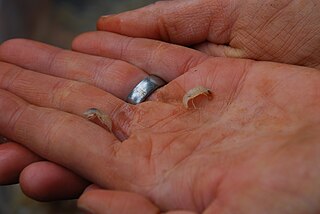 W
WAntrolana lira is a species of crustacean in family Cirolanidae, the only species in the genus Antrolana. It is an unpigmented troglobite with no eyes, reaching a maximum length of 0.7 inches (18 mm).
 W
WArquatopotamon jizushanense is a freshwater crab species found in Yunnan, China, and the only species of the genus Arquatopotamon. Its carapace is normally darkish brown and the walking legs and chelipeds more reddish brown.
 W
WThe tunnelling mud crab, Austrohelice crassa, is a marine large-eyed crab of the family Grapsidae, endemic to the sea coasts of New Zealand. Their carapace width is up to 40 mm.
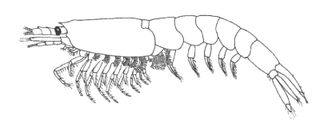 W
WBentheuphausia amblyops, the deep sea krill is a species of krill. B. amblyops is the only species within its genus, which in turn is the only genus within the family Bentheuphausiidae. All the 85 other species of krill known are classified in the family Euphausiidae.
 W
WThe coconut crab is a species of terrestrial hermit crab, also known as the robber crab or palm thief. It is the largest land-living arthropod in the world, with a weight up to 4.1 kg (9.0 lb). It can grow to up to 1 m in length from each tip to tip of the leg. It is found on islands across the Indian Ocean, and parts of the Pacific Ocean as far east as the Gambier Islands and Pitcairn Islands, similar to the distribution of the coconut palm; it has been extirpated from most areas with a significant human population, including mainland Australia and Madagascar.
 W
WBythotrephes longimanus, or the spiny water flea, is a planktonic crustacean less than 15 millimetres (0.6 in) long. It is native to fresh waters of Northern Europe and Asia, but has been accidentally introduced and widely distributed in the Great Lakes area of North America since the 1980s. Bythotrephes is typified by a long abdominal spine with several barbs which protect it from predators.
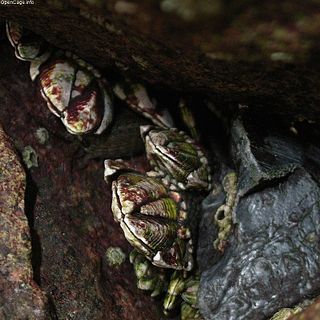 W
WCapitulum is a monotypic genus of sessile marine stalked barnacles. Capitulum mitella is the only species in the genus. It is commonly known as the Japanese goose barnacle or kamenote and is found on rocky shores in the Indo-Pacific region.
 W
WClistosaccus is a genus of barnacles which are parasitic on hermit crabs. It is a monotypic genus, and the single species is Clistosaccus paguri, which is found in the northern Atlantic Ocean and the northern Pacific Ocean.
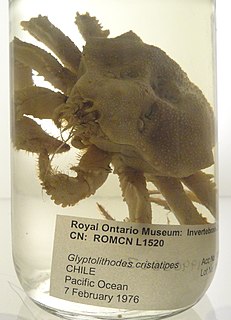 W
WGlyptolithodes cristatipes, also known as the Peruvian centolla, is a species of king crab, and the only species in the genus Glyptolithodes. The species was briefly placed in the related genus Rhinolithodes after its initial description, but was soon moved to its own genus.
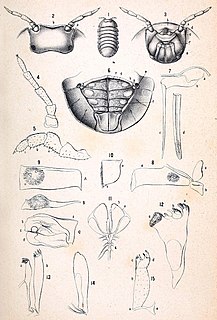 W
WHelleria brevicornis, the sole species of the monotypic genus Helleria, is a terrestrial woodlouse endemic to the islands and coastal regions of the northern Tyrrhenian sea. H. brevicornis is of interest due to its endemism, unique ecology and basal position in the suborder Oniscidea.
 W
WMarsupenaeus is a monotypic genus of prawn. It contains a single species, Marsupenaeus japonicus, known as the kuruma shrimp, kuruma prawn, or Japanese tiger prawn. It occurs naturally in bays and seas of the Indo-West Pacific, but has also reached the Mediterranean Sea as a Lessepsian migrant. It is one of the largest species of prawns, and is accordingly one of the most economically important species in the family.
 W
WNorthern krill, Meganyctiphanes norvegica, is a species of krill that lives in the North Atlantic Ocean. It is an important component of the zooplankton, providing food for whales, fish and birds. M. norvegica is the only species recognised in the genus Meganyctiphanes, although it has been known by several synonyms:Euphausia intermedia Euphausia lanei Holt & Tattersall, 1905 Meganyctiphanes calmani Nyctiphanes norvegicus G. O. Sars, 1883 Thysanopoda norvegica
 W
WMetopaulias is a monotypic genus of fully terrestrial land crabs which do not need to go back to the sea to spawn. Metopaulias depressus is a reddish-brown crab about 2 centimetres (0.79 in) wide which lives in the pools of water that form in the leaves of bromeliads in Jamaica. The female lays about 90 eggs, then tends to her offspring, removing dead leaves that would deoxygenate the water and adding snail shells to the pool to provide high levels of calcium that they require, catching cockroaches and millipedes to feed them, and killing larvae of the damselfly Diceratobasis macrogaster which would otherwise eat them.
 W
WNamibcypris costata is an extinct species of ostracod crustaceans in the family Candonidae, possibly endemic to the southern Kaokoveld in northern Namibia.
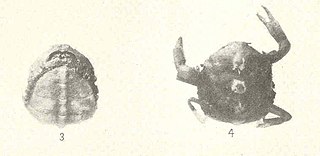 W
WTunicotheres is a monotypic genus of crabs in the family Pinnotheridae, and Tunicotheres moseri is the only species in the genus. This crab lives commensally in the atrial chamber of a small ascidian. It is found in the tropical western Atlantic Ocean, the Caribbean Sea and the Gulf of Mexico.